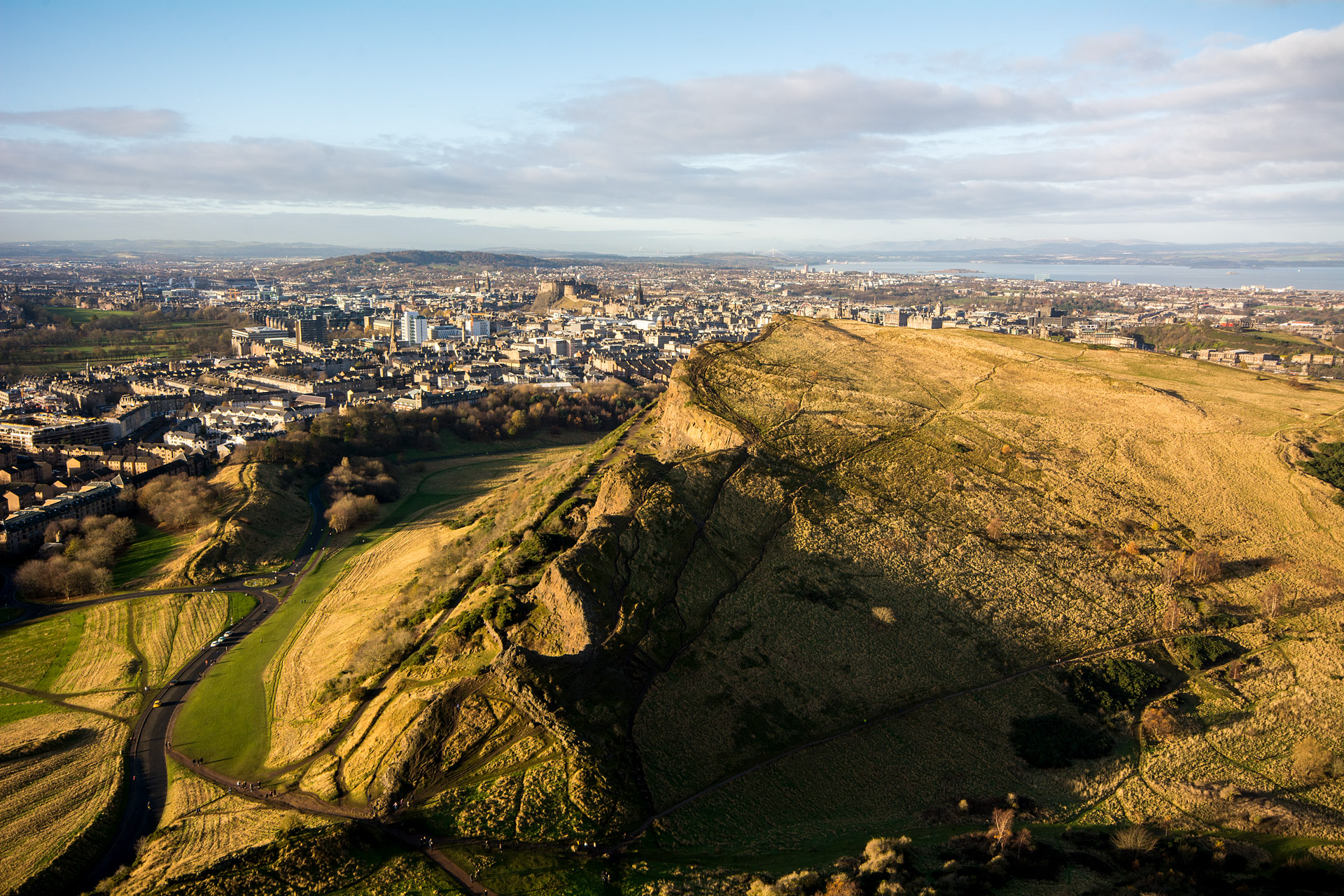We haven’t necessarily favored all the large capital cities we’ve visited, at least when compared to less crowded parts of the same countries (Ljubljana and Rome being notable exceptions); but with a population of less than a half million people, we thought we’d give Scotland’s small capital a chance to charm us.
We spent one morning exploring Holyrood Park, a 650-acre greenspace near the city center whose prominent peak is called Arthur’s Seat. Arthur’s Seat is an extinct volcano that had its last volcanic activity 285 million years ago, before being buried under mud and silt. Since then, plate movement in the Earth’s crust caused the volcano to tilt, and subsequent glacial activity carved away the softer layers, resulting in the hill’s peculiar angled slope. While the peak is a mere 823 feet above sea level, it’s an easily accessible walk that provides great views of the city skyline and the bay beyond. Clearly, though, it’s a lot less fun once winter sets in – while our route up to the top was reasonably solid, the path down the other side was a Slip ‘n’ Slide of mud and wet rocks. Hopefully the other passers-by weren’t too offended by our New England-style cursing as we tried to avoid skidding down the hill on our butts.
The beginning of our walk through the downtown area took us immediately underneath the imposing Edinburgh Castle, which stands atop Castle Rock – the plug of an extinct volcano that rises around 260 feet from the surrounding landscape. Since around the 11th century, there has been some form of castle on the rock, though evidence of inhabitants using the landmark as a strategic location dates back to the Iron Age. It’s been suggested that the Edinburgh Castle has been under siege more than any other castle in the United Kingdom, and was captured and recaptured by the Scots and the English for centuries.
Edinburgh’s downtown, overall, is really quite pleasant for walking, with many of the streets restricting the amount and type of traffic that’s allowed. St. Giles Cathedral is particularly beautiful, with its large, open steeple resembling a crown. A lighted Christmas tree stood out front, lending a festive atmosphere to the chilly air. We proceeded through the downtown and headed up Calton Hill to admire the various structures up there – the hill is home to a number of monuments and buildings, including the National Monument of Scotland, the Parliament House, and the City Observatory. The National Monument is what first caught our eye, and it turns out that the monument has remained unfinished since it was begun in 1826, originally intended to be a recreation of the Parthenon. Lack of funds and public interest have prevented any further work, so the series of Doric columns remains free-standing on the top of the hill.
Of course, what would a visit to Scotland be without trying their most famous dish? I am referring, naturally, to haggis – the blend of sheep’s heart, liver and lungs, typically mixed with oatmeal, onions and spices and stuffed into a casing made out of stomach. It sounded rather unpleasant, but Jenn rightfully pointed out that I have, at various times during this trip, eaten unknown pig parts floating in broth (Bangkok), bugs from a street cart (Phnom Penh), and tarantulas (also Cambodia). With that in mind, we made our way to The Royal McGregor for a sampling of Scottish beer and their signature haggis tower – a traditional serving of “haggis, neeps and tatties” – that is, haggis served with turnips and potatoes. The presentation was rather beautiful once the dish arrived, and after one tentative bite, I promptly devoured the whole plate, as Jenn looked on with slight revulsion. As it turns out, haggis, despite its odd and mild-nausea-inducing ingredient list, is freakin’ delicious.
Though we almost always enjoy the great outdoors more than city dwelling, we enjoyed wandering the streets of Edinburgh and admiring the seemingly-endless brown stone facades. We also loved the cheerful atmosphere created by all the holiday decorations, twinkling gold lights, and Christmas music that seemed to fill the town, putting us both in a festive mood. It seems that major capitals aren’t so bad – as long as they don’t get too big.


































